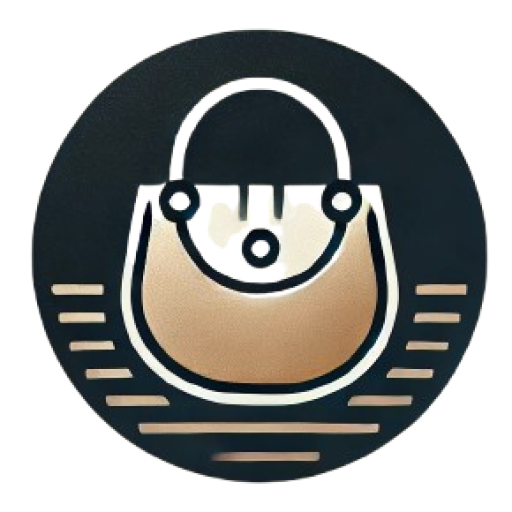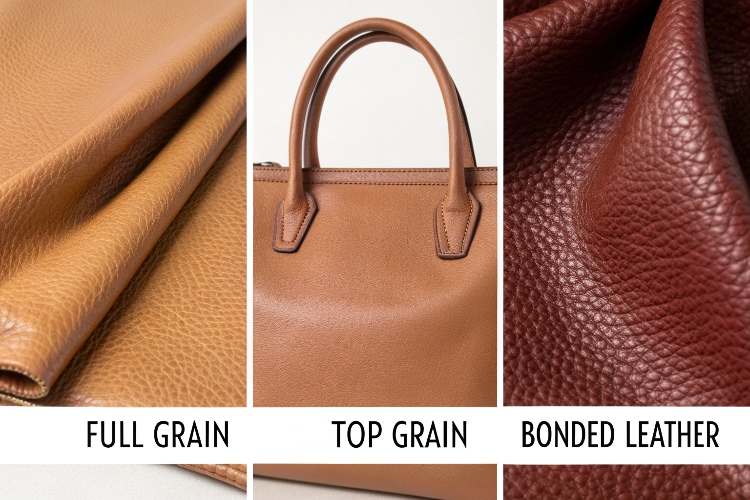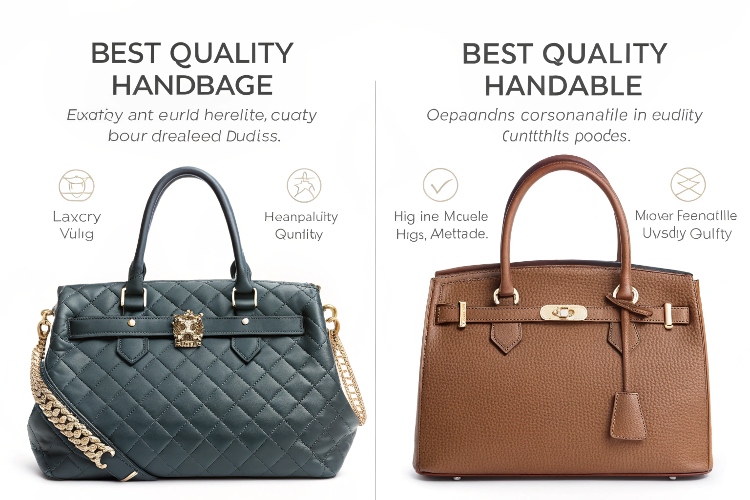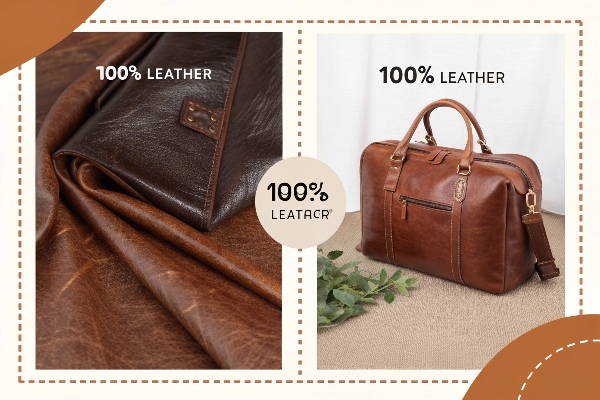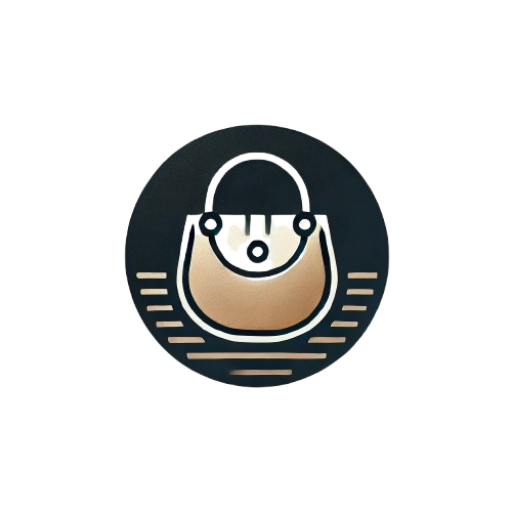Materials Used in Leather Bags:
- Primary Leather Types:
- Full-Grain Leather: Highest quality; retains natural grain, durable, ages beautifully.
- Top-Grain Leather: Sanded and polished for smoothness; lighter and more affordable.
- Vegetable-Tanned Leather: Eco-friendly, develops a patina over time.
- Split/Bonded Leather: Lower quality (reconstituted scraps or sanded hides); less durable.
- Exotic Leathers: Calfskin, ostrich, crocodile (luxury, rare).
- Non-Leather Components:
- Linings: Cotton, polyester, or suede for interior protection.
- Hardware: Zippers, clasps, and rivets (brass or stainless steel for durability).
- Threads/Adhesives: Reinforced stitching or glue for structure.
Key Tip: High-quality bags use full-grain or vegetable-tanned leather with sturdy hardware. Avoid “bonded leather” for longevity.
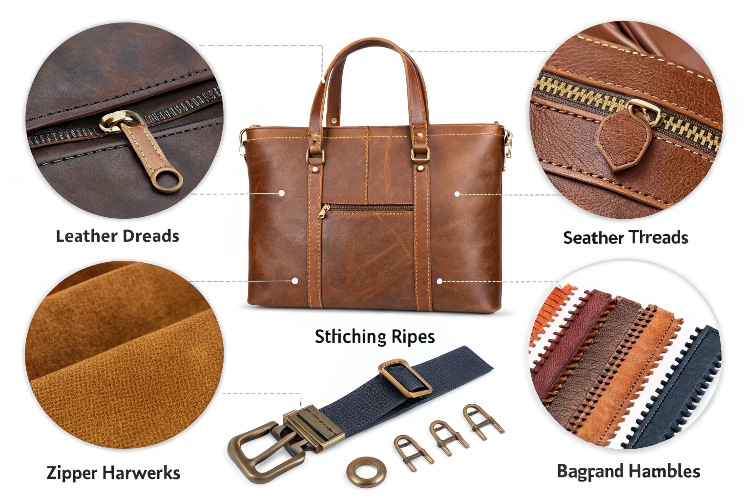
Material Categories (Animal Leather, Synthetic Leather, Canvas)
Animal Leather: The “Premium Option” of Natural Materials
The three most commonly used animal hides for genuine leather bags are: cowhide, sheepskin, and pigskin. Full-Grain Leather is the top-tier choice, showing natural textures on the surface that gain luster with use. Cowhide from Italy’s Tuscany region is the most sought-after, used by luxury brands like Hermès.
Sheepskin feels like butter, especially lambskin, but scratches easily. A little-known fact: Chanel’s classic flap bags actually use specially treated crinkled sheepskin, intentionally retaining crease marks to enhance durability.
Pigskin is more commonly used in China due to its porous breathability, often seen in wallet linings. Clarifying a misconception: Not all pebble-grained textures come from cowhide – cheaper bags often use embossed pigskin to mimic cowhide patterns.
Synthetic Leather: Affordable ≠ Low Quality
Modern high-end synthetic leather technology has advanced significantly. Microfiber Leather, for example, shows nearly identical structure to genuine leather under microscopes. A German luxury brand’s 2019 eco-collection used pineapple leaf fibers blended with synthetic leather, selling at higher prices than genuine leather versions.
Differentiate between PU and PVC: PU is breathable and soft for handbags, while PVC’s rigidity suits luggage. An industry secret: Italy’s Alcantara material (common in luxury car interiors) is actually synthetic leather, yet costs three times more than regular genuine leather.
Environmental concerns remain challenging. 2023 EU regulations now require synthetic leather manufacturers to disclose biodegradable percentages. Some factories currently use corn starch-based coatings that decompose 90% in specific solutions within six months.
Canvas: The Underestimated Performer
French canvas bag specialist Léon Flam started using 10oz heavy canvas (about credit card thickness) a decade ago – material originally designed for ship sails. An interesting test: Quality canvas won’t pill even after 20 rubs, while inferior products show damage after just five.
Modern trends favor organic cotton canvas blends. A Japanese artisan brand uses cotton mixed with hemp fibers, achieving 40% better mold resistance. Waterproofing techniques vary – premium versions use hand-applied beeswax and linseed oil, far more eco-friendly than chemical coatings.
Canvas bags fear deformation. A professional solution: Adding vegetable-tanned leather reinforcement plates to bag bottoms. A century-old Spanish workshop specializes in making replaceable leather accessories for canvas bags, allowing individual component replacement when worn.
Detailed Explanation of Auxiliary Materials (Hardware, Lining, Fillings)
Hardware: The “Joints” and “Facade” of Bags
Though small, hardware directly determines a bag’s lifespan. High-end international brands prefer copper alloy and stainless steel, like Italy’s Riri zippers and Japan’s YKK zippers – these materials show no rust after 24-hour saltwater immersion. Common brands use zinc alloy plating that discolors within six months.
A new trend emerged recently – German company HÄNSSLICH’s ceramic-coated hardware with 3x better scratch resistance than traditional metal. But the most practical remains classic brass buckles, whose oxidized patina develops character over time, as seen in British heritage brand Mulberry’s intentional aging effects.
Lining: The Hidden Technical Battleground
Modern leather bags increasingly use microfiber lining. Originally developed by NASA, this material reduces scratches from keys and hard objects. American brand Coach’s Signature series uses stain-resistant coated versions – coffee spills wipe clean instantly.
For ultimate luxury, Hermès uses goatskin lining – a palm-sized piece consumes an entire hide. Regular buyers should check lining seams – quality linings use rolled edges, while poor ones have raw edges with exposed threads prone to unraveling.
Fillings: The Invisible Skeleton Defining Shape
Tote bags maintain structure through double-layer corrugated cardboard invented in Japan. This material weighs 40% less than regular cardboard yet withstands 200,000 bends. The boxy Cambridge bag silhouette relies on thermo-shaped foam called “memory foam” by British artisans.
Eco-brands now experiment with corn fiber fill. Dutch brand Matt & Nat even uses recycled car seatbelts as structural support. Traditionalists insist on horsehair – this natural material allows organic puffiness, a craft still preserved by Florentine artisans.
Practical selection tip: Pinch the base and sides. Quality fillings show slight spring-back resistance, while inferior ones feel like soggy sponge cake. Visible white fibers at seams indicate low-grade synthetic fill.
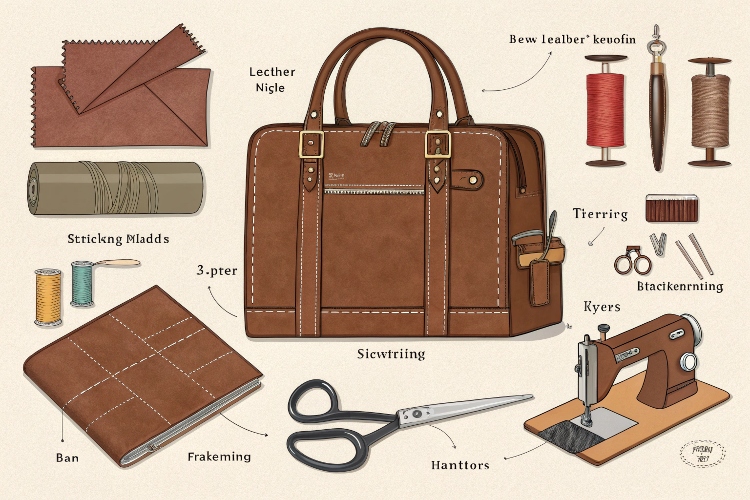
Eco-material Trends (Vegetable Tanning, Biodegradable Coatings)
Vegetable Tanning: Slow Craft Returning to Nature
European luxury leather brands now tout “vegetable-tanned leather”, essentially using tannic acid from tree bark and leaves to treat raw hides. Italy’s Tuscany region has practiced this since the 13th century, remaining the global hub for vegetable-tanned leather.
The most radical aspect lies in complete avoidance of chromium – a hazardous chemical used in 90% of conventional leather processing. U.S. Environmental Protection Agency (EPA) data shows traditional tanneries generate 300kg of chromium waste per ton of raw hide processed, while vegetable tanning wastewater can directly water plants.
Costs prove significant: 30-60 day processing cycles (vs. 1 day for chromium tanning) with 3-5x higher costs. A 2023 Polytechnic University of Milan study revealed vegetable-tanned leather has 15% lower tensile strength than conventional versions. This explains Hermès’ Birkin bags insist on this method while mass-market brands rarely follow.
Biodegradable Coatings: Installing a “Countdown” on Bags
The new term “compostable handbag” refers to microbial-digestible protective coatings. UK brand Vivobarefoot‘s 2022 sport bag collection used mushroom mycelium coating, testing shows it could degrade 78% in 6 months when buried.
Traditional PU/PVC coatings take centuries to decompose. The Netherlands’ Material Innovation Institute recently tested beet pulp extract coatings demonstrating 12,000 abrasion resistance cycles (vs. 20,000 for conventional coatings). The gap remains but meets daily use requirements.
A little-known fact: These coatings activate decomposition upon water contact. Brands now emphasize in bolded care instructions: “Avoid rain!” German outdoor brand Vaude even provides detachable coating modules – users replace dirty modules without discarding entire bags.
Market data proves decisive: Statista’s 2023 report shows eco-material bags command 47% price premiums yet have 22% lower return rates. Consumers willingly pay for genuine sustainability, but only when brands provide hard evidence like transparent supply chain tracking.
Material Impact on Price (Rarity vs Processing Cost)
Rarity: The “Limited Edition” of the Animal Kingdom
Crocodile skin shows this clearly. Price lists from Florida crocodile farms show a single intact belly crocodile hide sells for $200-500 per square foot, over 20 times more expensive than regular cowhide. This makes sense: crocodiles require four years of rearing before harvesting their hides, and artisans must manually remove 40+ bony plates during processing – one mistake ruins the whole hide. Ostrich skin proves even more extreme – only the palm-sized “pebble texture” area on each bird’s back qualifies as usable, requiring 3-4 hides to make a single handbag.
The Cost-Effectiveness Battle of Common Leathers
The 2023 U.S. Leather Council report reveals insights: regular cowhide dominates 73% of the market, but prices range from $50 to $2,000. The key lies in processing – full-grain leather retains natural textures with less than 60% material utilization, while suede achieves 85% waste recycling for lower costs. A little-known fact: vegetable-tanned leather costs more than chrome-tanned not because of materials, but time – the former soaks in tannin for 60 days versus 3 days for the latter.
Hidden Cost Killers in Processing
Italian heritage brands demonstrate this perfectly: using specialty plant oils from Tuscan villages for hand-rubbing leather immediately adds 40% to labor costs. Consider special techniques – Hermès crocodile skin dyeing requires 12 immersion cycles, each needing 48-hour drying periods, totaling 24 days just for coloring. Machines save time? Not necessarily! Automated cutters waste 15% more precious leather edges compared to master artisans’ hand-cutting – losses ultimately passed to consumers.
Where Your Money Actually Goes
Breakdown of a $3,000 crocodile bag: 55% raw hide, 30% processing, 15% certifications and shipping. Certification costs mainly go to CITES permits (Convention on International Trade in Endangered Species), starting at $200 per document. Shipping burns cash – from African farms to French workshops, constant refrigeration and humidity monitoring makes transport costs 8x higher than regular leather. Next time you see luxury prices, remember – brands might not pocket that cash.
The Hidden Price of Cheap Goods
Bangladesh Leather Union exposed industry secrets: budget “genuine leather” bags often use split leather – a pressed scrap material with 73% cracking risk within two years. Worse than that, 0.3mm polyurethane coatings make scrap leather look whole, but these bags shed “skin flakes” within six months. Not exaggerating – some $20 “genuine leather wallets” contain less than $0.50 worth of actual leather.
